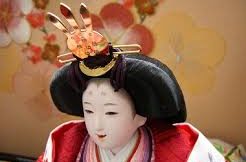There are many traditional, cultural events held on certain days in Japan. The third of March is a day for girls, called “hina matsuri.” It is a day families wish daughters happiness, good growth, and health. Traditionally, families with daughters display speciiial dolls called “o-hina-sama” a couple of weeks before the day and put them away several days after the day. O-hina-sama dolls are for display only, not to play with.
A first daughter of a family gets “o hina-sama” dolls prepared by her parents, gifted by her grandparents, or inherited from the family. O hina-sama varies in shape, material, size, and number of dolls. A simple set of o-hina-sama is a couple, an emperor and empress. Some sets of “o-hina-sama” are accompanied by people such as three maids with their service items and five court musicians with their music instruments. Some other sets have a wagon, plants, furniture, and sweets. A family chooses an “o-hina-sama” set depending on its budget or space available in the house. The daughters who were born after the first daughter usually do not get the same kind of “o-hina-sama” as their oldest sister did. Generally, daughters understood that “o-hina-sama” dolls are shared. Below are images of O-hina-sama from Google.
https://www.google.com/searchq=%E3%81%8A%E9%9B%9B%E6%A7%98&biw=1920&bih=945&tbm=isch&tbo=u&source=univ&sa=X&sqi=2&ved=0ahUKEwi8k_WA6Y7LAhVQwGMKHUlpBzEQsAQIGw
Families without daughters may also celebrate the day by a flower arrangement with peach blossoms. Pink petals of peach blossoms represent the hina matsuri. Hina-matsuri is not only a family event. Schools or businesses may display peach blossoms or “o-hina-sama”. Schools may hold hina-matsuri events. The traditional hina-matsuri song is sung or played for parties. You can listen to traditional music for the hina matsuri from YouTube.
https://www.youtube.com/watch?v=BcIfIrS8QJ0
In general, a family with a daughter or daughters has a special meal on the hina matsuri day, often Chirashi-zushi, or Chirashi-sushi. Chirashi-zushi is a type of sushi which has different ingredients on top of sushi rice. The colors of ingredients such as yellow eggs, green peas, and pink shrimps make a cheerful presentation and feeling of spring. The ingredients are also selected for the meanings they imply. Lotus pods have holes that imply clear visions; you can see things through holes. A Japanese word for peas is “mame” that implies be diligent. Shrimps, because of their curved shape, imply longevity until a back is bent by old age.
submitted by Miyoko Fuse

